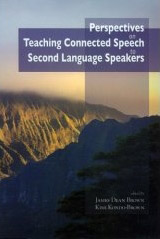On CUE Journal. Vol. 2, No. 1. Spring 2008. (p. 69 - 71)

Book Review -
Perspectives on Teaching Connected Speech to Second Language Learners
by James Dean Brown & Kimi Kondo-Brown (Eds.)
Honolulu: National Foreign Language Resource Center. 2006.
(ISBN: 978-0-8248-3136-3)
This volume contains 14 papers about connected speech, also frequently known as reduced speech. Its basic aim is to summarize what is known about connected speech and describe how it can be taught and tested.
The book starts off by highlighting recent research on connected speech. An interesting point suggested by Ito (p. 23) is that traditional ways of teaching connected speech seem to have limited effectiveness since they lack "meaningful communication". The classic debate between focus on form vs. content is raised, and Ito suggests skillful teachers need to do both.
After this a rationale for connected speech instruction is offered. A study of 32 Chinese graduate EFL students by Brown and Hilfery (pp. 56-57) suggests the value of explicit connected speech instruction. An experimental group of 16 students who received mini-lessons on reduced forms for four weeks on an intensive basis performed better on a dictation and grammar exercise than a control group receiving traditional instruction. However, a pre-test/post-test study of 20 Japanese business persons that got just seven 30-minute lessons on reduced forms for one month revealed no significant improvement in terms of TOEIC listening scores (p. 63).
| "Perhaps the best way to think of this work is as a collection of pioneering studies. Though many . . . are rough and about a quarter have been previously published, on the whole this volume contributes to the field of connected speech research." |
This book then moves on to consider how to teach connected speech in EFL/ESL contexts. A study by Rogerson (pp. 87-91) explores the attitudes of 45 ESL instructors towards reduced form instruction. Over half the respondents considered reduced forms "very important" and most reported explicitly teaching them in mini-lessons. Cahill (pp. 108 - 110) then describes one way to teach reduced forms through choral response, cloze dialogs, and dictations. Varden (pp. 129-165) also outlines a phonetic software package which visually displays speech patterns. Unfortunately, no empirical evidence of how this might help students monitor their speech is offered.
The book then turns to connected speech instruction in Japanese. A 1979 study by Hasegawa (pp. 173-187) shows how casual speech differs from fast speech. Toda (pp. 189-190) then debunks the myth that Japanese speakers always speak formally or politely. She also challenges the notion that listening skills invariably precede production skills, asserting that, ". . . from a pedagogical point of view, perceptual acquisition does not have to strictly precede acquisition of speech production" (p. 201). After this Hirata (pp. 234-243) argues for teaching words with subtle vowel/consonant contrasts in connected sentences rather than in isolation.
The final chapter ponders the issue of assessment. Brown and Kondo-Brown (pp. 248-264) mention over a dozen ways to construct tests that focus on reduced forms and concludes by recommending how to make tests more communicative. Emphasizing that testing reduced forms is really no different from testing any other language construct, they state, ". . . most of the various sorts of tests that teachers have been using for years to test other forms can also be used, or at least adapted with a little imagination, to test the various aspects of reduced forms. . ." (p. 264).
The Final Line
Few persons will want to tackle this book from cover to cover, but various parts will interest diverse groups. ESL/EFL teachers might find Chapters 4 and 8 useful. JSL/JSL teachers who actually prefer to read in English rather than Japanese should find some material in Chapters 11 and 13 valuable. Chapters 1, 3, and 10 are primarily for linguists. At times I wondered whether this book would not be more successful as several smaller, more tightly focused volumes. Perhaps the best way to think of this work is as a collection of pioneering studies. Though many of the studies are rough and about a quarter have been previously published, on the whole this volume contributes to the field of connected speech research. Since there are few books about this topic in print, it is a welcome addition.
- Tim Newfields
References
Brown, J. D., & Hilferty, A. (1987). The effectiveness of teaching reduced forms for listening comprehension. RELC Journal 17 (2). 59-70.
Hagen, S. A. (2000). Sound advice: A basis for listening comprehension (2nd edition). New York: Pearson Education.
Hasegawa, N. (1979). Casual Speech vs. Fast Speech. In P.R. Clyne, W.F. Hanks, & C.L. Hofbauer. Papers from the Fifteenth Regional Meeting, Chicago Linguistics Society, 126-37. April 19-20, 1979, Chicago, IL: Chicago Linguistics Society.
Ito, Y. (2001). Effect of reduced forms on ESL learners' input-intake process. Second Language Studies 20 (1) 99-124. Retrieved June 6, 2007 from http://www.hawaii.edu/sls/uhwpesl/20(1)/Ito.pdf
Rosa, M. (2002). Don'cha Know? A survey of ESL teachers' perspectives on reduced form instruction. Second Language Studies 21 (1), 49-78. Retrieved June 6, 2007 from http://www.hawaii.edu/sls/uhwpesl/21(1)/Rosa.pdf